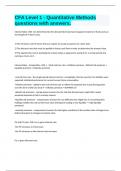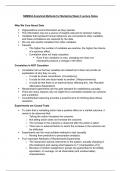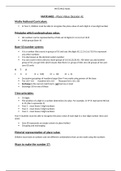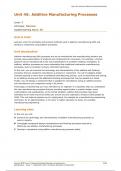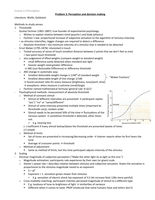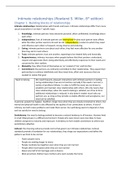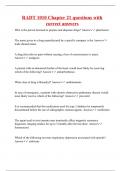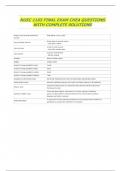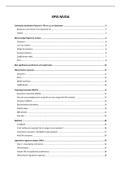questions with answers.
Interest Rates ANS -Are determined by the demand (borrowers)and supply (investors) of funds and can
be thought of in three ways:
1) The minimum rate of return that you require to accept a payment at a later date.
2) The discount rate that must be applied to future cash flow in order to determine the present value.
3) The opportunity cost of spending the money today as opposed to saving it for a certain period and
earning a return on it.
Interest Rates - Composition ANS -r = Real risk-free rate + Inflation premium + Default risk premium +
Liquidity premium + Maturity premium
-real risk-free rate - the single-period interest rate for a completely risk-free security if no inflation were
expected; individual preference for current versus future consumption
-inflation premium - added to the real risk-free rate to reflect the expected loss in purchasing power
over the term of the loan (real rf + inflation premium = NOMINAL rf)
-default risk premium - compensates investors for the risk that the borrower might fail to make
promised payments in full in a timely manner
-liquidity risk premium - compensates investors for any difficulty they might face in converting their
holdings readily into cash at their face value (infrequent trading or low liquidity => high liquidity
premium)
-maturity premium - compensates investors for the higher sensitivity of the market value of longer term
debt instruments to changes in interest rates
PV and FV rules ANS -For a given interest rate,
-the FV increases as N increases
-the FV increases as the interest rate increases
For a given discount rate,
,-the PV decreases as N increases
-the PV decreases as the discount rate increases
Annuity Due conversion ANS -Annuity payments at the beginning of the period.
Set calculator in BGN mode and insert data per usual.
OR
PV annuity due = PV ordinary annuity * (1+r)
FV annuity due = FV ordinary annuity * (1+r)
Stated Annual Interest Rate ANS -Interest rates are typically quoted as stated annual interest rates. To
unannualize, divide by the number of compounding periods N, which equals the periodic interest rate.
This is only a quoting convention!
Effective Annual Rate ANS -Takes the stated annual interest rate/periodic interest rate and converts it
into the annual rate that actually applies). It is the actual rate of interest that is actually being earned
after compounding more than annually. As the number of compounding periods increases, the FV
increases.
Frequency => Periodic Interest Rate (I/Y) => N compounding periods
Annual => r/1 => 1
Semiannual => r/2 => 2
Quarterly => r/4 => 4
Monthly => r/12 => 12
Daily => r/365 => 365
Continuous Compounding (Value) ANS -1. Multiply rate by time periods
2. Multiple answer by e (Second LN)
3. Multiply by PV
Present Value of Perpetuity ANS -Financial instrument that pays a fixed amount of money at set
intervals over an infinite period of time
, NPV ANS -Present Value of expected cash inflows (+) minus the present value of the expected outflows
(-), discounted at the appropriate cost of capital, which reflects the opportunity cost of undertaking the
investment and compensates investors for various risks in the investment. Assumes interim cash flows
from the project will be reinvested at the required rate of return.
Use the Calculator (Cash Flow):
Set CF0 = 0 (for profit)
Set CF0 = Initial negative outflow (for total NPV)
∑CF(t) / (1+r)^t
NPV Decision Rule ANS -If the investments NPV is positive, shareholder wealth is increased and the
project should be accepted.
If the investments NPV is negative, shareholder wealth is decreased and the project should be declined.
For mutually exclusive projects (where only one project may be accepted), the project with the highest
positive NPV should be chosen and would add the most value to the firm.
IRR ANS -The discount rate that equates the project's NPV to zero. Effectively, it is the discount rate that
equates the present value of all inflows from a project to the present value of all project-related
outflows. IRR assumes all cash flows from the project will be reinvested at the IRR.
Function of amount and timing of cash flows. Independent of cost of capital
Capital Budgeting ANS -The allocation of funds to relatively long range projects or investments
IRR vs. NPV (Mutually Exclusive) ANS -Always accept the project with the greatest NPV when the IRR
and NPV rules are conflicting.
If the IRR is greater than the required rate of return, NPV is positive.
If the IRR is less than the required rate of return, NPV is negative.

